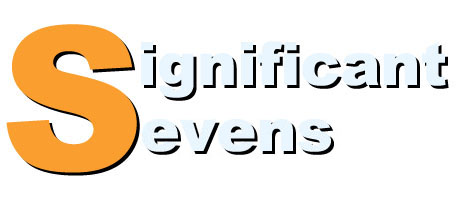Deep Blue: Computer Chess Champion
Deep Blue was a chess-playing computer that a team of people at IBM developed to defeat the reigning world chess champion, Garry Kasparov. In 1997, their efforts paid off. During a one-week period in May of 1997, Kasparov and a human representative of IBM, acting on instructions from Deep Blue, squared off in a rematch of a contest that had occurred a year before. That time, Kasparov had won. The second time, the computer won.
Hsu moved on from that to develop a computer called Deep Thought. Also working on Deep Thought were Thomas Anantharaman, Mike Browne, Murray Campbell, and Andreas Nowatzyk. Deep Thought, named after a computer in Douglas Adams’ famous book series The Hitchhiker’s Guide to the Galaxy, made headlines in 1988 when it defeated Danish grandmaster Bent Larsen. The computer met its match in Kasparov the following year, however, losing both games to the Russian champion. Kasparov in 1985 had become the youngest-ever undisputed world chess champion. He was 22 and made headlines around the world for defeating the reigning champion, Anatoly Karpov. Kasparov was the top-ranked chess player in the world for 225 out of the next 228 months, retiring in 2005. Hsu and the team at IBM went on to develop another chess-playing computer, this one named Deep Blue, after IBM’s nickname of “Big Blue.” Development of Deep Blue, with the addition to the team of grandmaster Joel Benjamin, continued for the next several years. In the mid-1990s, the team declared itself ready for another challenge, and Kasparov agreed to play against the new computer.
Deep Blue’s developers made some improvements to the computer and challenged Kasparov again. The rematch occurred the following year. Again it was a six-match series. Again it took place during a seven-day period, from May 10 to May 17, in 1997, in New York. Kasparov won the first game. Deep Blue countered with a win in the second game. The next three games ended in a draw. So heading into the final game, the score was tied at 2–2. Deep Blue then won the final game, achieving an overall victory with a final score of 3–2.
Kasparov announced that he wanted a rematch. That didn’t happen. Instead, IBM decommissioned Deep Blue. One of the two towers that made up Deep Blue is on display at the National Museum of American History, in Washington, D.C. The other tower is on display at the Computer History Museum, in Mountain View, Calif. The story of Deep Blue and its chess battles with Kasparov has appeared in books and on film. IBM moved on in its quest to build human-defeating computers; one result was another game-playing computer, named Watson, which defeated all human opponents on the TV quiz show Jeopardy! in 2011. |
|
Social Studies for Kids
copyright 2002–2026
David White



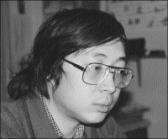 The story of this titanic struggle on a chessboard starts further back in time, in the mid-1980s. Feng-hsiung Hsu (left), a computer scientist originally from Taiwan, arrived at Pittsburgh’s Carnegie Mellon University to do his graduate work in 1985. His chosen field of study was computer chess. Hsu called his project ChipTest.
The story of this titanic struggle on a chessboard starts further back in time, in the mid-1980s. Feng-hsiung Hsu (left), a computer scientist originally from Taiwan, arrived at Pittsburgh’s Carnegie Mellon University to do his graduate work in 1985. His chosen field of study was computer chess. Hsu called his project ChipTest. 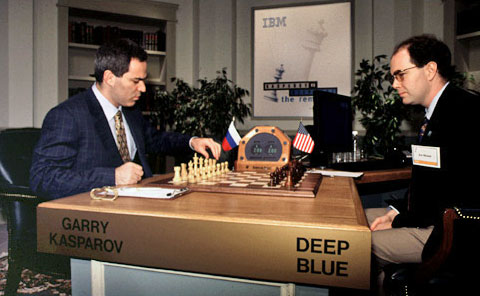 The six-game match occurred February 10 to February 17, in 1996, in Philadelphia. Kasparov sat on one side of the chessboard; on the other side sat a person who made the moves suggested by the computer. Deep Blue won the very first game. However, that was the last game the computer would win. Kasparov won three of the next five (games 2, 5, and 6), and the other two ended in a draw. Kasparov was declared the winner by a score of 4–2. (Chess scoring awards 1 point to each game’s winner; a draw earns each player ½ point.) Kasparov won $400,000 of the $500,000 prize; the other $100,000 went to the Deep Blue team.
The six-game match occurred February 10 to February 17, in 1996, in Philadelphia. Kasparov sat on one side of the chessboard; on the other side sat a person who made the moves suggested by the computer. Deep Blue won the very first game. However, that was the last game the computer would win. Kasparov won three of the next five (games 2, 5, and 6), and the other two ended in a draw. Kasparov was declared the winner by a score of 4–2. (Chess scoring awards 1 point to each game’s winner; a draw earns each player ½ point.) Kasparov won $400,000 of the $500,000 prize; the other $100,000 went to the Deep Blue team.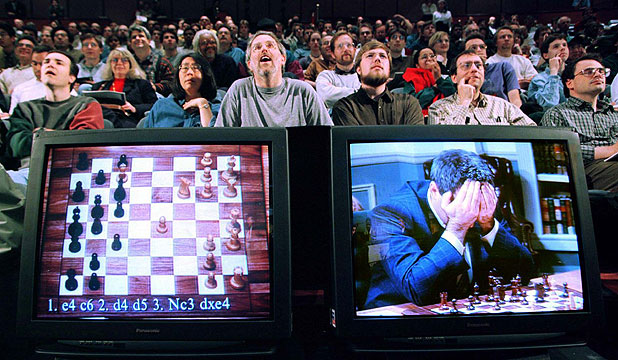 The victory was not without intrigue or controversy. Chess players and fans, along with a sizable number of the general public, watched some or all of the games live on television. Unlike the first series, which took place in an auditorium, the 1997 series of chess games took place in a TV stadium. The Deep Blue team contained one grandmaster and had the input of several more. Deep Blue’s “intelligence” included familiarity with Kasparov’s victories and tendencies. Kasparov did not have reciprocal information: The Deep Blue team refused to share with him the results of other games in which the computer had taken part (although he did study many popular computer chess games during his preparation). As well, Kasparov said later that he noticed some signs of creativity and other non-computer behavior, suggesting that perhaps a human or two had intervened in the transfer of instructions from computer to human surrogate.
The victory was not without intrigue or controversy. Chess players and fans, along with a sizable number of the general public, watched some or all of the games live on television. Unlike the first series, which took place in an auditorium, the 1997 series of chess games took place in a TV stadium. The Deep Blue team contained one grandmaster and had the input of several more. Deep Blue’s “intelligence” included familiarity with Kasparov’s victories and tendencies. Kasparov did not have reciprocal information: The Deep Blue team refused to share with him the results of other games in which the computer had taken part (although he did study many popular computer chess games during his preparation). As well, Kasparov said later that he noticed some signs of creativity and other non-computer behavior, suggesting that perhaps a human or two had intervened in the transfer of instructions from computer to human surrogate.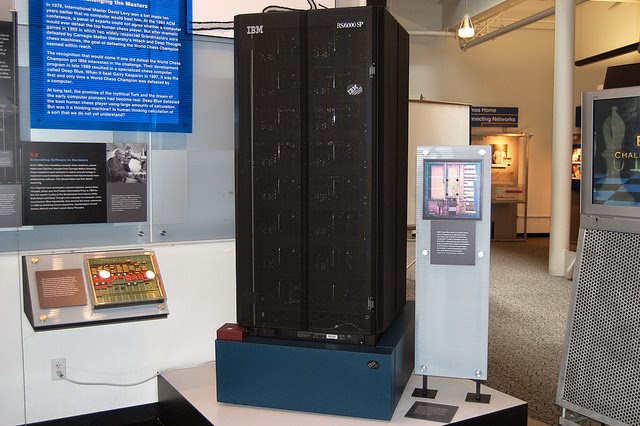 As it stood, the computer was capable of evaluating 200 million chess board positions a second, far outstripping the ability of the human brain to do the same. But some observers found that the computer relied too much on sheer computation; indeed, some of Kasparov’s more unexpected moves throughout the two six-game series served as a disruption to the computer’s normally lightning-quick move decisions.
As it stood, the computer was capable of evaluating 200 million chess board positions a second, far outstripping the ability of the human brain to do the same. But some observers found that the computer relied too much on sheer computation; indeed, some of Kasparov’s more unexpected moves throughout the two six-game series served as a disruption to the computer’s normally lightning-quick move decisions. 

